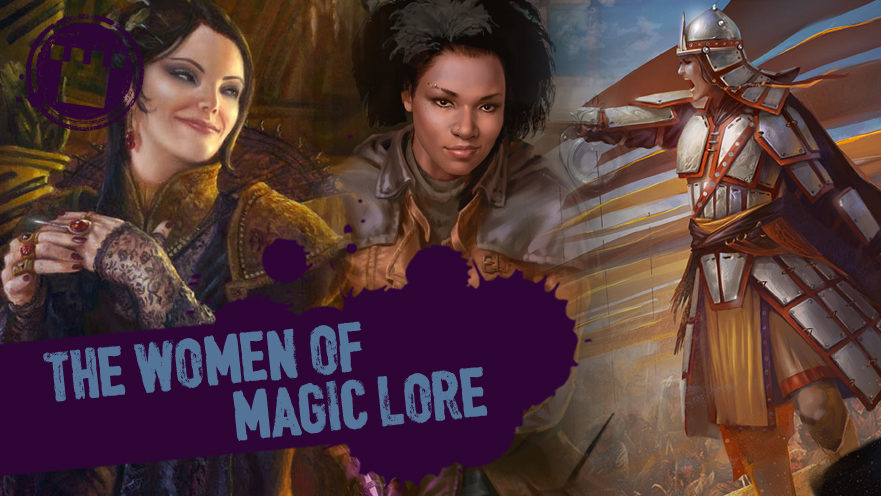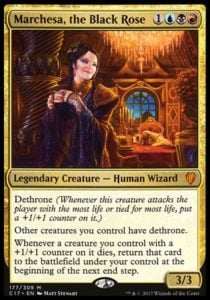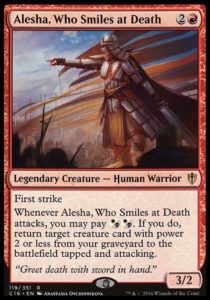One of the best aspects of Magic is its worldbuilding, creating universes and characters that feel both wonderous and relatable. Part of what makes so many of Magic’s most memorable characters familiar isn’t just their power level or abilities, but also who they are as characters. Nowhere is this more clear than with Magic’s portrayal of women over the past few years, showing them as not only powerful mages and legendary creatures, but as people with their own differing motives, methods and ideologies.
Hailing from every part of the color pie, the women of Magic lore bring their own spin to the fantasy genre. We don’t just see attractive, thin, alabaster-skinned damsels in distress or femme fatales, but women of power who are intelligent, competent, and strong in their own ways. As Women’s History Month draws to a close, let’s take a look at some of the most interesting and powerful women in Magic lore and see what their color identities show us about who they are.
Marchesa, The Black Rose
When we first meet Marchesa, she is an established player in the game of thrones in the high city of Paliano. Subtle, elegant, and powerful, her path to power lies in her wealth, extensive network of spies and assassins, and knowledge of poisons. Almost every part of her image and every action she takes is meticulously thought out, even down to her jewelry:
“Marchesa also wore a ring on each finger, each expensive and ornate. The biggest was the ruby she wore on her left middle finger. Each ring housed a different poison, but the ruby contained the deadliest on Fiora.” ( “The Black Rose”, Matt Knicl)
As a blue, black and red character, Marchesa d’Amati’s intelligence and ambition are fueled by her passions. She can calculate the moves of her enemies and allies, staying several steps ahead in order to survive. Though Marchesa is a master of subtle machinations, her strengths lie in her cunning, understanding of people, and resources – not her appearance. In her final meal with her friend-turned-enemy Ervos, he discerns every move and countermove she would make, with her final gambit involving his assassination. As he poisons himself over their last meal (believing himself to be the winner in their game), Marchesa reveals she was aware of his plan all along.
“Instead, she walked out of the room to summon her butler, who had been in the backyard since before Ervos arrived, digging a hole for his body. Marchesa knew her rival would take his own life, but she wanted him to have the final victory as he died, even if she had known his play all along.” (“The Black Rose”, Matt Knicl)
Marchesa’s sudden ascension to the throne of Palliano during the events of Conspiracy: Take The Crown is executed with the smoothness of a well-oiled machine, with every piece clicking into place. Her confidence that the plan will be perfectly executed is absolute, with servants already beginning to install her furnishings right before King Brago is assassinated. Marchesa’s color identity shifts as she ascends the throne, exchanging her blue mana for white, which marks her new commitment to rule and order. She is no less deadly and meticulous about her appearance and network of spies and assassins, but she has a new focus for them – to establish control and dominance.
“Her handmaidens disassembled her, revealing layer after hidden layer. Gown. Partlet. Farthingale. Kirtle. Petticoat. Bodice. When she was down to her stockings and shift, the handmaidens built her back up again, this time in garments more luxurious and finely made than before. Adriana could see the stitches that hid countless inner pockets, the secret lining to conceal pouches of rare poisons. Bodice. Petticoat. Kirtle. Farthingale. Partlet. Gown. The handmaidens topped the endless opulence by securing a chest plate.
There was no seduction in this chore, only a simple dominance when the queen met eyes with her captain of the guard. Endless layers containing endless secrets. Do you see how much I carry? Can you fathom how much I hide?” (“Tyrants”, Alison Luhrs)
The simple act of disrobing and clothing oneself becomes a challenge to Marchesa’s enemy, Adriana, the Captain of the Guard: I may present myself as vulnerable, but between us, it is you who has more to fear. In the tumultuous first weeks of her reign, it remains to be seen whether Marchesa can hold her position as the monarch of Paliano, but there is no doubt that she is a strong, capable woman and a dangerous foe.
Kaya
Though she is a planeswalker, Kaya’s interest and scope of activity are much more focused than the world-bending, plane-dominating goals of others. She is an assassin, and one with a very specific range of skills: the ability to become partially incorporeal and dispatch ghosts to their final rest. This makes her services particularly coveted among a certain class of clientele, and it’s reflected in her prices and her professional yet cavalier demeanor.
“What Kaya did was seen as blasphemous by some, a disruption of the natural order of life beyond death. But in other belief systems it was the ghosts themselves who were disrupting the natural order, and Kaya who was setting things right. She’d been showered with blessings some places and run out of town in others, all for doing the same thing. Whatever the ultimate destiny of the dead on any given world, it was Kaya’s personal conviction that they weren’t fulfilling it by hanging around being a nuisance to the living.” (“Laid to Rest”, Kelly Digges)
Despite her line of work, Kaya is a person of principle, which is reflected in her white and black color identity. While she does put herself first, her ability to interact with the departed gives her insight into the darker motivations of the living. Though she prefers the living to the dead (the living, after all, can pay her), she does have hard lines that can be crossed. Upon discovering her client murdered their own mother, she doesn’t hesitate to dispense her own sense of justice.
“Revari turned to her, still on his knees, eyes wide.
‘Help me,” he said. ‘I’ll pay you—I’ll pay double!’
‘Your own mother,’ said Kaya. ‘You can rot in hell.’
….Then his mother’s wailing ghost was upon him with those needle teeth and those dagger claws. Kaya walked through the closed door in a flash of purple-white light, leaving mother and son to their sad, sorry business. Kaya smoothed her jacket, turned, and walked away.” (“Laid To Rest”, Kelly Digges)
Kaya’s principles and admiration for order are seen again in her exchange with Adriana. After Kaya assassinates the ghost king Brago, she lays out her reasoning for accepting the job.
“ ‘I heard he was an empty suit long before I put my dagger in him. And before that he was a tyrant,’ the assassin said. ‘As long as tyrants die, the chance for freedom lives.’ (“Tyrants”, Alison Luhrs)
Though she is a rich character filled with nuance and understandable motivations, Kaya is also notable for being the first black woman Planeswalker. While the majority of the women portrayed as Planeswalkers are presented as white (or another fantasy race), it is refreshing and necessary to see a black woman written as a fully developed, multidimensional character. Even her character art is a statement, illustrating her with a smirk on her face, functional, practical clothing and natural hair. Since she was created in partnership with Monique Jones, an entertainment writer who is herself a black woman, the black experience is captured in the details of Kaya’s story:
“Kaya lit a candle, yawned, and splashed her face with water from a basin. She rolled out the building plans and studied them one last time, humming an old ballad and unwinding the knots she’d put her hair in to sleep.” (“Laid To Rest”, Kelly Digges)
Though it’s a small detail, the practice of styling hair into knots before sleeping to create natural curls is a common practice amongst black women. This kind of experience makes Kaya a much more believable, relatable character, not just a one-dimensional token person of color. While we are used to seeing women of color, particularly black women, portrayed as victims or without power, we are given a strong counterargument to this stereotype with Kaya. We probably have not seen the last of her, but the practice of bringing in consultants to help create amazing characters of color is hopefully here to stay.
Alesha, Who Smiles At Death
One of the most compelling women of Magic isn’t a Planeswalker, a Mage or a Queen, but a Khan. Though she is not the first woman to assume the title, she is the first trans woman to take leadership of one of the most powerful Clans of Tarkir, the terrifying and swift Mardu. Inspired in part by the Mongols, the Mardu Horde are a culture of warriors, conquest and victory, raiding nearby villages and clans on horseback to gain provisions and prizes. Embodying the swiftness of the dragon, the Mardu have taken the wings of the ancient beasts as their sigil. Honor and glory are to be found in the kill, as long as it is done by the Edicts of Ilagra: “To conquer is to eat.” “To rule is to bleed.” “Victory or death.”
It is through understanding the Mardu that Alesha herself can be understood. Before earning her war name with her first kill, she was another soft-heel (unproven warrior), uncertain and unsure. Upon slaying her first dragon, she had the opportunity to rename herself, an opportunity that was not without risks.
“What she remembered was the panic that came after. Earning her war name had been her only goal. When the fight was over, she stood silently among the other young ones who were boasting of their accomplishments and the bold, grisly names they would choose…She had been so different—only sixteen, a boy in everyone’s eyes but her own, about to choose and declare her name before the khan and all the Mardu….
Then the khan came to Alesha. She stood before him, snakes coiling in the pit of her stomach, and told how she had slain her first dragon. The khan nodded and asked her name.
‘Alesha,’ she said, as loudly as she could. Just Alesha, her grandmother’s name.
‘Alesha!’ the khan shouted, without a moment’s pause.
And the whole gathered horde shouted ‘Alesha!’ in reply. The warriors of the Mardu shouted her name.” (“The Truth of Names”, James Wyatt)
To the Mardu, and to Alesha, finding your true self comes through victory and blood, and your war name – your true name – is a reflection of that self. In a culture that prizes these principles above all else, it is both remarkable and logical that a woman like Alesha can be given the opportunity to be her authentic self. That passion for truth, honor and camaraderie to the exclusion of everyone outside of the Mardu clan is perfectly captured by their red, white and black color identity. In the same way, Alesha’s character embodies the clan’s commitment to fierce individual conquest for the good of the whole. The search for self-discovery comes to a head on the battlefield, and it is this self-knowledge with which a warrior can earn recognition from peers.
“ ‘I have a tale of the battle.’
She turned and glared at him. ‘We have heard enough of your deeds.’
‘This is not my glory.’ He raised his voice so all around could hear. ‘Today I saw a warrior strike down a dragon with a single blow, and on her face she wore the joy of battle.’
Alesha smiled.
The orc took a step closer and spoke more quietly. ‘As you say, my khan, I do not know myself. But I know you, I follow you—’
Now he shouted over all the din of the battlefield. ‘—and I call you Alesha, Who Smiles at Death.’
And once again, the warriors of the Mardu shouted her name.” (“The Truth of Names”, James Wyatt)
The fact that a trans woman is deliberately portrayed in this game as a person of fierce passion, leadership and action is revolutionary. In the real world, the violence against and murder of trans women is real and tragic, so to present a clear retort to this is a bold move on the Magic team’s part. Alesha is not just a trans woman surviving in a brutal world – she is a trans woman thriving in a role of power. That in and of itself helps to broaden our idea of what trans women can be, and in many ways, should be. Though her story has ended in the distant past of Tarkir, her impact continues to be felt not just within what remains of the Mardu Horde, but outside the lore as well.
Conclusion
There are countless women that I haven’t covered in this article that span the long 25-year length of Magic’s history. However, what connects almost all of Magic’s female and female-presenting characters is a singular focus to keep them strong and motivated. Though some might argue that portraying women of all backgrounds as rulers, scientists, warriors or politicians might be unrealistic, I would counter that these characters are vital in showing us not just where we are now, but where and who we can be in the future. I very much look forward to seeing what powerful women we meet next, and how a game rooted in fantasy can influence the reality around us.

A consummate lover of books, tea, food and instant-speed kill spells, Michelle is a person of many passions. Her hobbies include cuddling cats, throwing pottery, and analyzing Magic lore from a literary perspective. She is also a co-host of the Vorthos comedy podcast, “The Loregoyfs,” and she comprises a full 25% of The Felidar Guardian (specifically the right hand, left ear and both scapulas). Her CMC is 2BWU, and her ETB trigger creates two 1/1 cats with lifelink and trample.





